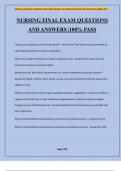EMILLECT 2024/2025 ACADEMIC YEAR ©2024 EMILLECT. ALL RIGHTS RESERVED FIRST PUBLISH OCTOBER, 2024
NURSING FINAL EXAM QUESTIONS
AND ANSWERS |100% PASS
How can you estimate a client's tidal volume? - Answer✔✔-Tidal volume can be estimated by
observing the depth of the client's respirations.
What is the range of normal for an adult's respiratory rate? - Answer✔✔-A rate of 12 to 20
breaths per minute is normal for adults
Besides the rate, what other characteristics of a client's respirations should you observe? -
Answer✔✔-Depth, rhythm, effort, breath sounds, and chest movement should be observed in
addition to rate.
What are some common clinical signs associated with poor oxygenation? - Answer✔✔-Pallor or
cyanosis of the nails, lips, or skin; restlessness; apprehension; confusion; dizziness; fatigue;
changes in pulse and blood pressure; and decreased level of consciousness are associated with
poor oxygenation.
Which of the Korotkoff sounds would you record as the systolic pressure? - Answer✔✔-First
Which of the Korotkoff sounds would you record as the diastolic pressure? - Answer✔✔-Fifth
Page 1/43
,EMILLECT 2024/2025 ACADEMIC YEAR ©2024 EMILLECT. ALL RIGHTS RESERVED FIRST PUBLISH OCTOBER, 2024
A nurse is auscultating a BP. He hears the first sound at 170 mm Hg. The sound disappears
immediately. At 150 mm Hg, the sound appears again and continues until there is silence at 80
mm Hg. The pressures were taken in the client's right arm while the client was lying down.
How should the nurse record these pressures? - Answer✔✔-BP RA, supine, 170/80 with an
auscultatory gap from 170 to 150
How do you explain what happened? - Answer✔✔-An auscultatory gap occurred. A gap is most
commonly heard in hypertensive clients, whose systolic blood pressure is higher than the adult
normal limit of 140 mm Hg.
Which of the following patients has hypertension? One with a BP of:
150/80 on two separate occasions
180/100 on one occasion
138/88 on two occasions - Answer✔✔-150/80 on two separate occasions
Which of the following client(s) has/have primary hypertension?
Client A, who is obese and has a high sodium intake
Client B, who is in renal failure
Client C, who has hypertension induced by pregnancy
Page 2/43
,EMILLECT 2024/2025 ACADEMIC YEAR ©2024 EMILLECT. ALL RIGHTS RESERVED FIRST PUBLISH OCTOBER, 2024
Client D, who has a family history of hypertension - Answer✔✔-Client D, who has a family
history of hypertension
What are five functions of the skin? - Answer✔✔-The skin serves five functions: protection,
sensation, temperature regulation, secretion/excretion, and formation of vitamin D.
How does the skin help regulate body temperature? - Answer✔✔-The skin contains sensory
organs or receptors for heat and cold. The skin regulates temperature through the process of
dilating and constricting blood vessels and activating or inactivating sweat glands. The sweat
glands found in the axillae and external genitalia secrete fatty acids and proteins and excrete
perspiration, which produces a cooling effect as the moisture evaporates from the skin.
What changes take place in the skin as a person ages - Answer✔✔-With age, both layers of the
skin become thinner and more fragile. As collagen and elastin fibers in the dermis deteriorate,
the skin becomes wrinkled. Sebaceous and sweat gland activity decreases, causing the skin to
become dry, scaly, and itchy, and temperature regulation in hot weather becomes more difficult.
As the number and activity of hair follicles and pigment cells (melanocytes) diminishes, hair
becomes thin, turns gray or white, and grows more slowly. Nails thicken and growth decreases.
These changes increase the risk for skin problems.
True or false: The professional nurse is responsible for making assessments. - Answer✔✔-True
True or false: Assisting with the bath is an excellent time to assess the patient. - Answer✔✔-
True
Page 3/43
, EMILLECT 2024/2025 ACADEMIC YEAR ©2024 EMILLECT. ALL RIGHTS RESERVED FIRST PUBLISH OCTOBER, 2024
To inspect for pallor in a dark-skinned person, which areas would you assess for an ashen gray
or yellow color? - Answer✔✔-For dark-skinned persons, the conjunctivae, buccal mucosa,
tongue, lips, nail beds, palms, and soles should be assessed for pallor.
What is the term that means "a bluish color of the skin"? - Answer✔✔-Cyanosis means a bluish
discoloration of the skin.
Name two causes of erythema. - Answer✔✔-Vasodilation and inflammation are causes of
erythema.
Where can you best see jaundice? - Answer✔✔-The sclera of the eyes is the best place to see
jaundice
True or false: Healthy nails are usually clean, smooth, and convexly curved - Answer✔✔-True
List at least three nail changes that occur with aging. - Answer✔✔-As a person ages, the nails
thicken, become ridged, and may yellow or become concave in shape.
List at least four things you should teach clients about self-care of their nails. - Answer✔✔-
Answer:
Clients should be taught the following self-care of their nails:
● Inspect the nails daily.
● Trim nails with a nail clipper (people with diabetes or circulatory problems should file only, as
cutting poses a risk for injury to the tissues).
Page 4/43




